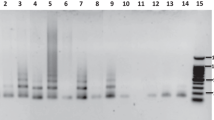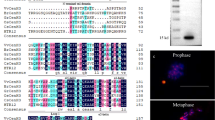Abstract
Oryza officinalis (CC, 2n=24) and Oryza rhizomatis (CC, 2n=24) belong to the Oryza genus, which contains more than 20 identified wild rice species. Although much has been known about the molecular composition and organization of centromeres in Oryza sativa, relatively little is known of its wild relatives. In the present study, we isolated and characterized a 126-bp centromeric satellite (CentO-C) from three bacterial artificial chromosomes of O. officinalis. In addition to CentO-C, low abundance of CentO satellites is also present in O. officinalis. In order to determine the chromosomal locations and distributions of CentO-C (126-bp), CentO (155 bp) and TrsC (366 bp) satellite within O. officinalis, fluorescence in situ hybridization examination was done on pachytene or metaphase I chromosomes. We found that only ten centromeres (excluding centromere 7 and 2) contain CentO-C arrays in O. officinalis, while centromere 7 comprises CentO satellites, and centromere 2 is devoid of any detectable satellites. For TrsC satellites, it was detected at multiple subtelomeric regions in O. officinalis, however, in O. rhizomatis, TrsC sequences were detected both in the four centromeric regions (CEN 3, 4, 10, 11) and the multiple subtelomeric regions. Therefore, these data reveal the evolutionary diversification pattern of centromere DNA within/or between close related species, and could provide an insight into the dynamic evolutionary processes of rice centromere.





Similar content being viewed by others
References
Alexandrov I, Kazakov A, Tumeneva I, Shepelev V, Yurov Y (2001) Alpha-satellite DNA of primates: old and new families. Chromosoma 110:253–266
Amor DJ, Choo KH (2002) Neocentromeres: role in human disease, evolution, and centromere study. Am J Hum Genet 71:695–714
Amor DJ, Kalitsis P, Sumer H, Choo KH (2004) Building the centromere: from foundation proteins to 3D organization. Trends Cell Biol 14:359–368
Benson G (1999) Tandem repeats finder: a program to analyze DNA sequences. Nucleic Acids Res 27:573–580
Cheng Z, Buell CR, Wing RA, Gu M, Jiang J (2001) Toward a cytological characterization of the rice genome. Genome Res 11:2133–2141
Cheng Z, Dong F, Langdon T, Ouyang S, Buell CR, Gu M, Blattner FR, Jiang J (2002) Functional rice centromeres are marked by a satellite repeat and a centromere-specific retrotransposon. Plant Cell 14:1691–1704
Clarke L, Carbon J (1985) The structure and function of yeast centromeres. Annu Rev Genet 19:29–55
Cleveland DW, Mao Y, Sullivan KF (2003) Centromeres and kinetochores: from epigenetics to mitotic checkpoint signaling. Cell 112:407–421
Crooks GE, Hon G, Chandonia JM, Brenner SE (2004) WebLogo: a sequence logo generator. Genome Res 14:1188–1190
Dong F, Miller JT, Jackson SA, Wang GL, Ronald PC, Jiang J (1998) Rice (Oryza sativa) centromeric regions consist of complex DNA. Proc Natl Acad Sci USA 95:8135–8140
Dover GA (2005) Molecular drive in multigene families: how biological novelties arise, spread and are assimilated. Trends Genet 2:159–165
Ge S, Sang T, Lu BR, Hong DY (1999) Phylogeny of rice genomes with emphasis on origins of allotetraploid species. Proc Natl Acad Sci USA 96:14400–14405
Hall TA (1999) BioEdit: a user-friendly biological sequence alignment editor and analysis program for Windows 95/98/NT. Nucleic Acids Symp Ser 41:95–98
Harrison GE, Heslop-Harrison JS (1995) Centromeric repetitive DNA sequences in the genus Brassica. Theor Appl Genet 90:157–165
Henikoff S, Dalal Y (2005) Centromeric chromatin: what makes it unique? Curr Opin Genet Dev 15:177–184
Henikoff S, Malik HS (2002) Centromeres: selfish drivers. Nature 417:227
Henikoff S, Ahmad K, Malik HS (2001) The centromere paradox: stable inheritance with rapidly evolving DNA. Science 293:1098–1102
Hizume M, Shibata F, Matsusaki Y, Garajova Z (2002) Chromosome identification and comparative karyotypic analyses of four Pinus species. Theor Appl Genet 105:491–497
Houben A, Brandes A (1996) Molecular-cytogenetic characterization of a higher plant centromere/kinetochore complex. Theor Appl Genet 93:477–484
Jiang J, Birchler JA, Parrott WA, Kelly DR (2003) A molecular view of plant centromeres. Trends Plant Sci 8:570–575
Kawabe A, Nasuda S (2005) Structure and genomic organization of centromeric repeats in Arabidopsis species. Mol Genet Genomics 272:593–602
Kipling D, Warburton PE (1997) Centromeres, CENP-B and Tigger too. Trends Genet 13:141–145
Kishii M, Tsujimoto H (2002) Genus-specific localization of the TaiI family of tandem-repetitive sequences in either the centromeric or subtelomeric regions in Triticeae species (Poaceae) and its evolution in wheat. Genome 45:946–955
Kumar S, Tamura K, Nei M (2004) MEGA 3: integrated software for molecular evolutionary genetics analysis and sequence alignment. Brief Bioinform 5:150–163
Kumekawa N, Ohmido N, Fukui K, Ohtsubo E, Ohtsubo H (2001) A new gypsy-type retrotransposon, RIRE7: preferential insertion into the tandem repeat sequence TrsD in pericentromeric heterochromatin regions of rice chromosomes. Mol Genet Genomics 265:480–488
Kuznetsova IS, Prusov AN, Enukashvily NI, Podgornaya OI (2005) New types of mouse centromeric satellite DNAs. Chromosome Res 13:9–25
Lee HR, Zhang W, Langdon T, Jin W, Yan H, Cheng Z, Jiang J (2005) Chromatin immunoprecipitation cloning reveals rapid evolutionary patterns of centromeric DNA in Oryza species. Proc Natl Acad Sci USA 102:11793–11798
Martinez-Zapater JM, Estelle MA, Somerville CR (1986) A highly repeated DNA sequence in Arabidopsis thaliana. Mol Gen Genet 204:417–423
Miller JT, Dong F, Jackson SA, Song J, Jiang J (1998) Retrotransposon-related DNA sequences in the centromeres of grass chromosomes. Genetics 150:1615–1623
Murata M, Ogura Y, Motoyoshi F (1994) Centromeric repetitive sequences in Arabidopsis thaliana. Jpn J Genet 69:361–370
Murray MG, Thompson WF (1980) Rapid isolation of high molecular weight plant DNA. Nucleic Acids Res 8:4321–4325
Nagaki K, Cheng Z, Ouyang S, Talbert PB, Kim M, Jones KM, Henikoff S, Buell CR, Jiang J (2004) Sequencing of a rice centromere uncovers active genes. Nat Genet 36:138–145
Nagaki K, Neumann P, Zhang D, Ouyang S, Buell CR, Cheng Z, Jiang J (2005) Structure, divergence, and distribution of the CRR centromeric retrotransposon family in rice. Mol Biol Evol 22:845–855
Nakajima R, Noma K, Ohtsubo H, Ohtsubo E (1996) Identification and characterization of two tandem repeat sequences (TrsB and TrsC) and a retrotransposon (RIRE1) as genome-general sequences in rice. Genes Genet Syst 71:373–382
Sambrook J, Russell DW (2001) Molecular cloning: a laboratory manual, 3rd edn. Cold Spring Harbor Laboratory Press, Cold Spring Harbor, pp 1.132–1.142
Sun X, Wahlstrom J, Karpen G (1997) Molecular structure of a functional Drosophila centromere. Cell 91:1007–1019
Talbert PB, Bryson TD, Henikoff S (2004) Adaptive evolution of centromere proteins in plants and animals. J Biol 3:18
Tek AL, Jiang J (2004) The centromeric regions of potato chromosomes contain megabase-sized tandem arrays of telomere-similar sequence. Chromosoma 113:77–83
Thompson JD, Gibson TJ, Plewniak F, Jeanmougin F, Higgins DG (1997) The CLUSTAL_X windows interface: flexible strategies for multiple sequence alignment aided by quality analysis tools. Nucleic Acids Res 25:4876–4882
Ugarkovic D, Plohl M (2002) Variation in satellite DNA profiles—causes and effects. EMBO J 21:5955–5959
Vaughan DA, Morishima H, Kadowaki K (2003) Diversity in the Oryza genus. Curr Opin Plant Biol 6:139–146
Willard HF (1991) Evolution of alpha satellite. Curr Opin Genet Dev 1:509–514
Zhang D, Yang Q, Bao W, Zhang Y, Han B, Xue Y, Cheng Z (2005) Molecular cytogenetic characterization of the Antirrhinum majus genome. Genetics 169:325–335
Zhao T, Wu T, Xie Y, Wu R (1989) Genome-specific repetitive sequences in the genus Oryza. Theor Appl Genet 76:835–840
Acknowledgments
The anti-OsCENH3 peptide antibody against rice CENH3 was kindly provided by Dr. S. Henikoff (Howard Hughes Medical Institute). This work was supported by grants from the Ministry of Sciences and Technology of China (2005CB120805), the Chinese Academy of Sciences and the National Natural Science Foundation of China (30325008 and 30530070).
Author information
Authors and Affiliations
Corresponding author
Additional information
Communicated by W. R. McCombie
Rights and permissions
About this article
Cite this article
Bao, W., Zhang, W., Yang, Q. et al. Diversity of centromeric repeats in two closely related wild rice species, Oryza officinalis and Oryza rhizomatis . Mol Genet Genomics 275, 421–430 (2006). https://doi.org/10.1007/s00438-006-0103-2
Received:
Accepted:
Published:
Issue Date:
DOI: https://doi.org/10.1007/s00438-006-0103-2




